How to Make Orange Juice at Home: Delicious and Healthy
Wake up to the vibrant sunshine of fresh orange juice right in your kitchen! Learning how to make orange juice at home turns an ordinary morning into a nutrient-packed experience. It connects you directly with nature’s sweetest gift. Fresh squeezed orange juice isn’t just a drink—it’s a celebration of flavor, health, and simple culinary joy.
Imagine starting your day with a glass of pure, natural orange juice that you’ve crafted yourself. No preservatives, no added sugars—just fresh, delicious goodness straight from nature. Whether you’re a health enthusiast or simply someone who loves great taste, creating your own orange juice recipe is easier than you might think.
This guide will walk you through everything you need to know about making the most delicious homemade orange juice. From selecting the perfect oranges to mastering juicing techniques, you’ll become an expert in creating a refreshing drink that beats any store-bought alternative.
Table of Contents
Key Takeaways
- Fresh orange juice offers maximum nutritional benefits
- Homemade juice takes just 10 minutes to prepare
- Navel oranges are the best choice for juicing
- Rolling oranges helps maximize juice extraction
- Drink immediately for peak flavor and nutrients
Benefits of Making Fresh Orange Juice at Home
Discovering the goodness of orange juice is more than just a refreshing drink. Making it at home brings health benefits and nutritional advantages that store-bought juice can’t offer.
The nutritional value of orange juice is amazing. An 8-ounce serving gives you over 100% of your daily vitamin C. This supports your immune system and overall health. Here are the main benefits of homemade orange juice:
- Boosts immune system function
- Supports heart health by reducing LDL cholesterol
- Provides essential antioxidants
- Helps maintain healthy blood pressure
Health Benefits and Nutritional Powerhouse
Fresh orange juice is a nutrient powerhouse. It can change your daily wellness routine. The benefits of orange juice go beyond basic nutrition. Studies show it:
- Improves cognitive function
- Reduces inflammation
- Supports skin health through collagen production
- Aids in preventing chronic diseases
Cost-Effectiveness and Quality
Homemade orange juice is more affordable and nutritious than store-bought. You choose the ingredients, avoiding added sugars and preservatives. This ensures maximum freshness.
Taste and Freshness Advantage
The vibrant flavor of freshly squeezed orange juice is unmatched. Making juice at home gives you the purest taste and highest nutritional value. You get the essence of ripe, juicy oranges in every glass.
Pro tip: Consume one glass daily for optimal health benefits and immune system support.
Best Types of Oranges for Juicing
Looking for the best oranges for juicing? Different types have unique qualities. Not all oranges are great for making fresh juice.
Here are the top oranges for juicing to make your homemade juice better:
- Valencia Oranges: Known as the “queen of juice,” these oranges are the ultimate choice for juicing. They have a peak season from April through June and offer an exceptional juice yield.
- Navel Oranges: The most common variety, navel oranges are sweet, seedless, and incredibly juicy. They’re available from November to January and typically produce about 1/2 cup of juice per fruit.
- Blood Oranges: These unique oranges bring an intense flavor with hints of raspberry. They’re in season from December to July and provide a stunning deep red juice.
Pro tip for juicing oranges: Roll your oranges on the counter before juicing to increase your juice yield by approximately 20%. This simple technique helps break down the internal membranes, releasing more juice.
When selecting oranges for juicing, look for fruits that are:
- Heavy for their size
- Have thin, smooth skin
- Feel slightly soft when gently squeezed
Did you know that there are more than 600 types of oranges worldwide? While not all are ideal for juicing, varieties like Cara Cara and Valencia stand out for their exceptional juice quality. Experiment with different types to find your perfect juicing orange!
Essential Tools and Equipment for Orange Juicing
To make fresh orange juice, you need the right tools. Whether you’re just starting or you’re a pro, the right juicer makes a big difference. It affects how your juice tastes and how healthy it is.
Choosing the right equipment depends on your budget, how easy you want it to be, and how good you want your juice to taste. Each tool can turn fresh oranges into a tasty drink.
Manual Juicing Tools
Manual juicers are cheap and easy to use. They include:
- Hand-held citrus squeezers
- Wooden reamers
- Lever-style juicers
The best manual juicers are light, about 13.1 ounces, and small, around 5.31 x 7.09 x 5.12 inches. They can juice small to medium oranges in about 30 seconds.
Electric Juicer Options
Electric juicers are faster and more efficient. Here are some popular ones:
| Brand | Motor Power | Capacity | Price Range |
|---|---|---|---|
| Zulay Citrus Juicer | 160W | 16 ounces | $$ |
| Vinci Electric Juicer | 70W | 16 ounces | $$ |
| FOHERE Electric Juicer | 90W | 33.8 ounces | $$ |
Blender Method Equipment
Blenders are a great alternative for making orange juice. They can blend at speeds up to 20,000 RPM. Look for blenders with:
- Sharp stainless steel blades
- Multiple speed settings
- Easy-to-clean components
When picking your juicer, think about the motor power, how much juice it can make, how easy it is to clean, and what you like about making juice.
How to Make Orange Juice: Step-by-Step Guide
Making the perfect orange juice is simple. Just a few steps can turn fresh oranges into a tasty drink in your kitchen.
Before starting, get these things ready:
- Fresh, ripe oranges
- Cutting board
- Sharp knife
- Juicing tool (manual or electric)
- Strainer (optional)
- Pitcher or container
Here’s a basic recipe for a vitamin C-rich orange juice:
- Pick ripe, heavy oranges with smooth skin
- Wash oranges well under cool water
- Cut oranges in half with a sharp knife
- Decide how to juice:
- Manual hand squeezing
- Electric citrus juicer
- Blender method
- Get all the juice out
- Strain pulp if you want
- Drink it right away for the best nutrition
Pro Tip: Valencia oranges give the most juice and taste great.
Pro tip: Adding a small piece of fresh ginger or turmeric (up to 5 grams) can make your juice taste even better.
| Orange Type | Juice Yield | Flavor Profile |
|---|---|---|
| Valencia | Highest | Sweet, balanced |
| Navel | Moderate | Sweet, seedless |
| Blood Orange | Medium | Unique, vibrant color |
Freshly squeezed orange juice has about 124 mg of Vitamin C per serving. That’s 150% of what you need daily. Enjoy your homemade juice within 24 hours for the best taste and nutrition!
Manual Squeezing Technique for Fresh Orange Juice
Making fresh squeezed orange juice by hand is an art. It brings out the most vibrant flavors and nutrients. You can create delicious orange juice right in your kitchen with minimal equipment.
When selecting oranges for fresh squeezed orange juice, choose fruits that are:
- Slightly soft to the touch
- Heavy for their size
- Bright and unblemished
Pro orange juicing tips for manual squeezing include warming your oranges in the microwave for 20-30 seconds. This simple trick helps release more juice and makes squeezing easier. Cut your oranges lengthwise to maximize juice extraction.
For optimal results, use these manual juicing methods:
- Hand Reamer: Press and twist the cut orange half against the pointed tool
- Citrus Press: Place orange half and press down firmly
- Simple Squeeze Method: Use your hands to manually extract juice
One orange typically yields 4-5 tablespoons of juice. To get a full cup of fresh orange juice, you’ll need about 3 oranges. Remember that heavier fruits usually indicate higher juice content.
Fresh, manually squeezed orange juice delivers the most authentic and nutritious drinking experience!
Using an Electric Citrus Juicer Method
Making fresh orange juice is super easy with an electric orange juicer. These tools make extracting juice from citrus fruits simple. You can enjoy fresh, healthy drinks in just minutes.
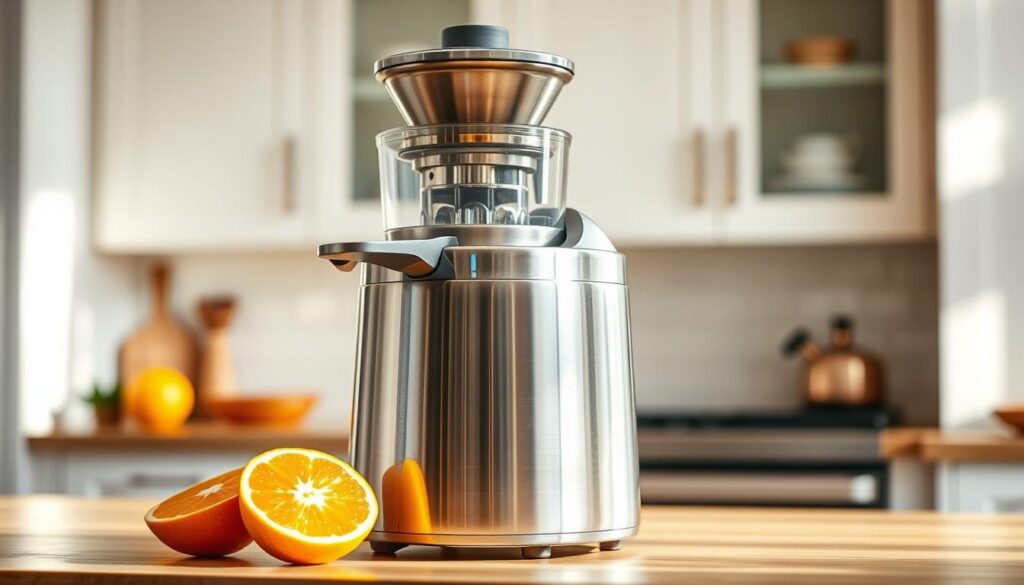
Preparing Your Citrus Fruits
Before juicing, it’s important to prepare your oranges right. Choose ripe, room-temperature oranges for the best juice. Here’s how to prepare:
- Wash oranges well to get rid of dirt or residue
- Roll oranges on the counter to make them softer and juicier
- Cut oranges in half crosswise for easy juicing
- Warm oranges slightly in the microwave for 10-15 seconds to get more juice
Operating Your Electric Citrus Juicer
Using an electric orange juicer is easy. Most have a simple press-and-squeeze design. Here’s how to use it:
- Put a glass under the juice spout
- Put the orange half on the juicing cone
- Lower the lever or press the start button
- Let the machine do the work
- Rotate orange halves to get more juice
Cleaning and Maintenance
Keeping your electric orange juicer clean is important. Most are dishwasher-safe, making cleaning easy. Rinse parts right after use to stop pulp from drying.
Regular cleaning stops bacteria and keeps your juicer working well. Clean the outside with a damp cloth. Make sure all parts you can remove are clean after each use.
Blender Method for Orange Juice Making
Juicing oranges with a blender is easy and flexible. It lets you make fresh orange juice at home. You can also add your favorite ingredients to make it special.
This method keeps more fiber than other ways. It’s great for adding different flavors to your juice.
To make your own orange juice, follow these steps:
- Choose ripe, fresh oranges for the best taste
- Peel oranges completely, removing all white membrane
- Remove seeds to avoid a bitter taste
- Cut oranges into small pieces for easy blending
Here are some important tips for blending oranges:
- Use a strong blender for the best results
- Blend oranges for about one minute
- Add a bit of water to get the right consistency
- Strain the mix if you want smoother juice
Pro tip: Try adding strawberries or a bit of ginger to your orange juice for extra flavor. The blender method lets you make juice that’s just right for you.
Homemade juice made with a blender stays fresh for 24-48 hours in the fridge. This way, you can always have fresh, healthy orange juice ready.
Storage Tips and Shelf Life
Keeping your homemade orange juice fresh is key. The right storage methods help keep the taste and nutrients good.
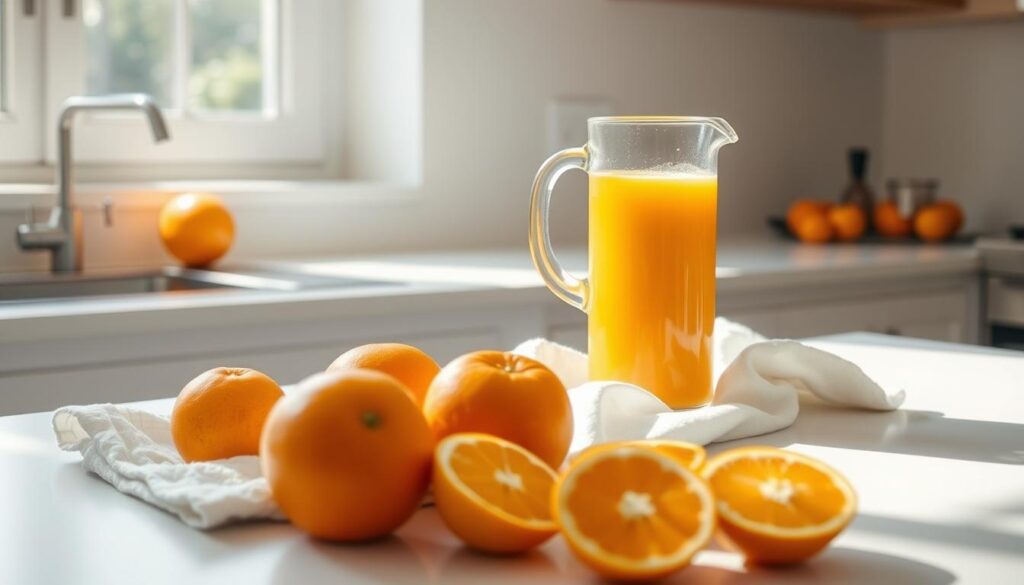
Storing your juice right is important. It keeps your juice fresh and safe. The shelf life depends on a few things.
Proper Container Selection
The container you choose affects your juice’s freshness. Glass containers with tight lids are best. Stay away from plastic, as it can change the taste.
- Use clean, airtight glass bottles
- Choose containers with minimal air exposure
- Opt for dark or opaque containers to protect from light
Refrigeration Guidelines
Keeping your juice cold is crucial. The best fridge temperature is 35-40°F (1.6-4.4°C). This slows down nutrient loss and stops bacteria.
| Storage Method | Shelf Life |
|---|---|
| Refrigerated (Airtight Container) | 7-10 days |
| Freshly Squeezed | 2-3 days |
| Pasteurized (No Preservatives) | 5-7 days |
Freezing Methods
Freezing is great for keeping juice for a long time. Pro tip: Use ice cube trays for easy portions. Frozen juice stays good for 8-12 months at 0°F (-18°C).
- Fill freezer-safe containers, leaving some space for expansion
- Label containers with the date of freezing
- Thaw in the refrigerator when ready to consume
Follow these tips to keep your homemade orange juice fresh and full of nutrients.
Nutritional Information and Health Benefits
Orange juice is a nutritional powerhouse. One cup has 112 calories and twice the Vitamin C you need daily. It also has 2 grams of protein, 27 grams of carbs, and 496mg of potassium.
Vitamin C in orange juice boosts your immune system and aids in healing. It also has folate, important for preventing birth defects. Plus, it has polyphenols that fight inflammation, especially after eating fatty foods.
Enjoying orange juice in small amounts can be good for you. It has potassium citrate, which may lower kidney stone risk. But remember, it’s high in sugar, making up 42% of your daily intake on a 2,000-calorie diet. Eating whole fruits and controlling portions will help you enjoy its benefits.

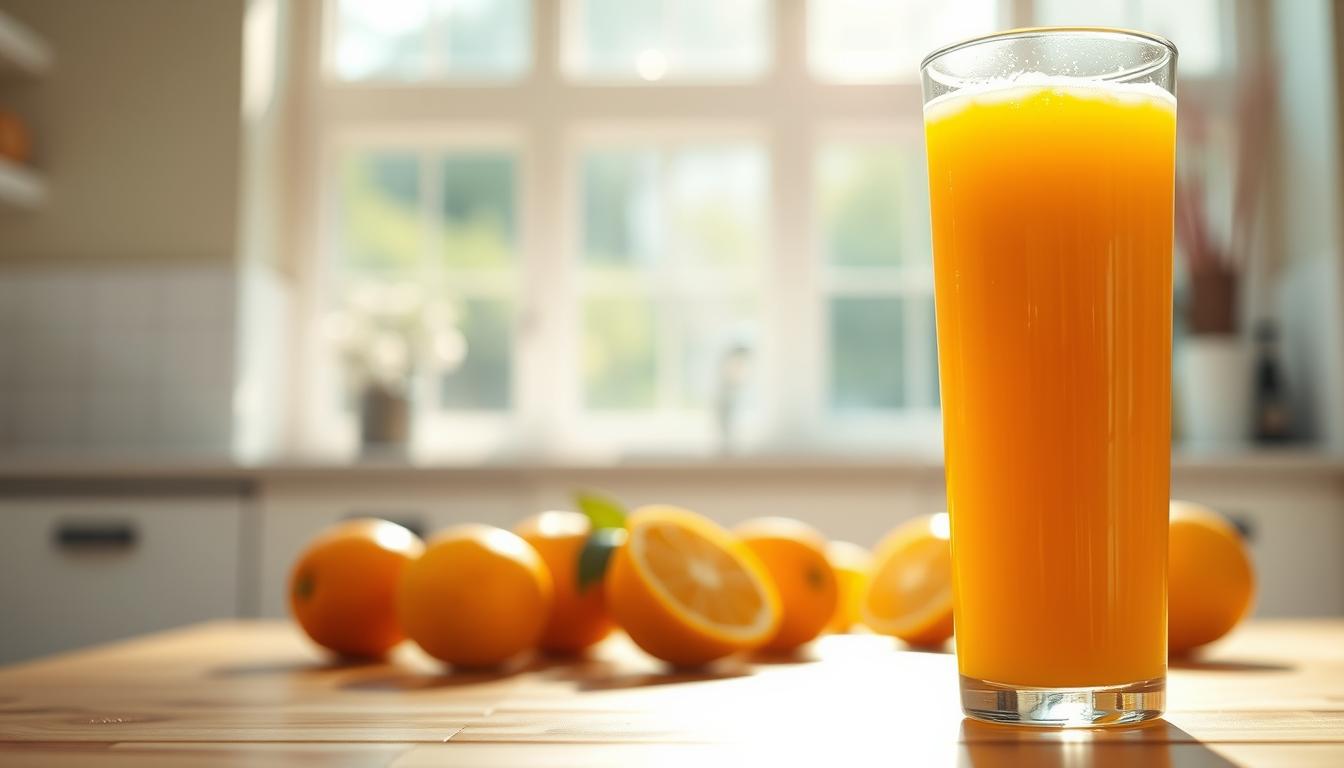

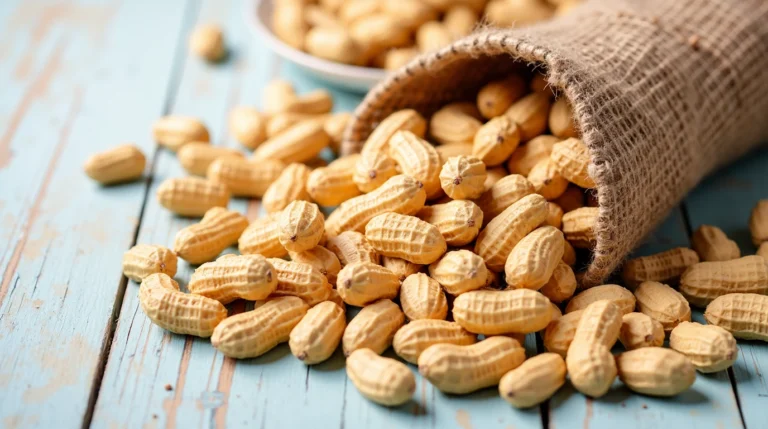
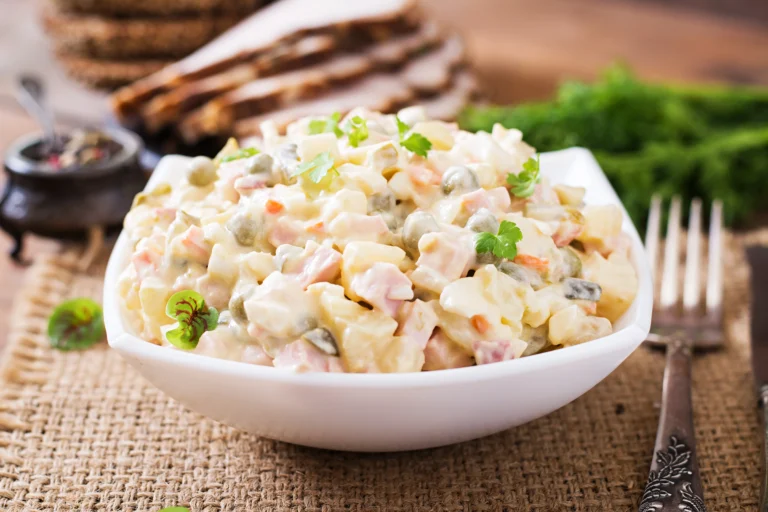
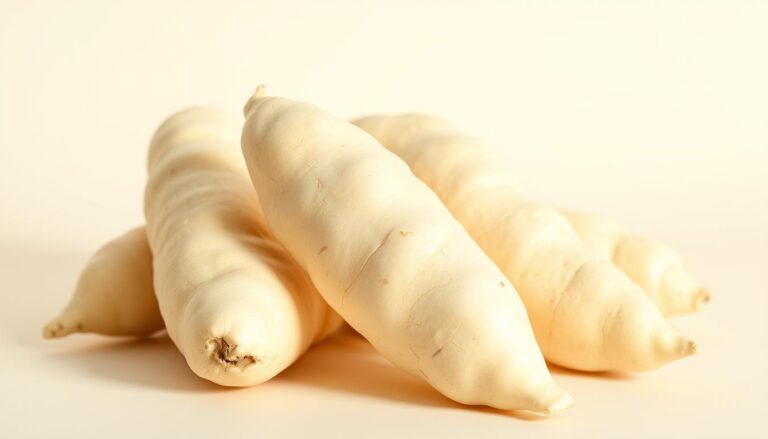

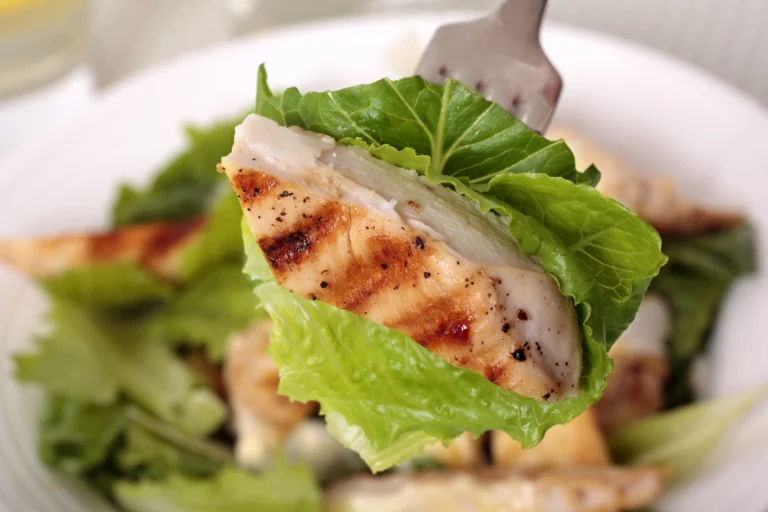
One Comment
Comments are closed.